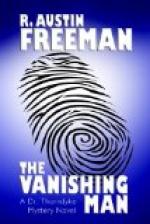“What are these experiments that Doctor Thorndyke refers to?” she asked presently.
“I can only answer you rather vaguely,” I replied. “Their object, I believe, is to ascertain whether the penetrability of organic substances by the X-rays becomes altered by age; whether, for instance, an ancient block of wood is more or less transparent to the rays than a new block of the same size.”
“And of what use would the knowledge be, if it were obtained?”
“I can’t say. Experiments are made to obtain knowledge without regard to its utility. The use appears when the knowledge has been acquired. But in this case, if it should be possible to determine the age of any organic substance by its reaction to X-rays, the discovery might be of some value in legal practice—as in demonstrating a new seal on an old document, for instance. But I don’t know whether Thorndyke has anything definite in view; I only know that the preparations have been on a most portentous scale.”
“How do you mean?”
“In regard to size. When I went into the workshop yesterday morning, I found Polton erecting a kind of portable gallows about nine feet high, and he had just finished varnishing a pair of enormous wooden trays, each over six feet long. It looked as if he and Thorndyke were contemplating a few private executions with subsequent post-mortems on the victims.”
“What a horrible suggestion!”
“So Polton said, with his quaint, crinkly smile. But he was mighty close about the use of the apparatus all the same. I wonder if we shall see anything of the experiments, when we get there. This is Museum Street, isn’t it?”
“Yes.” As she spoke, she lifted the flap of one of the little windows in the back of the cab and peered out. Then, closing it with a quiet, ironic smile, she said:
“It is all right; he hasn’t missed us. It will be quite a nice little change for him.”
The cab swung round into Great Russell Street, and, glancing out as it turned, I saw another hansom following; but before I had time to inspect its solitary passenger, we drew up at the Museum gates. The gate-porter, who seemed to expect us, ushered us up the drive to the great portico and into the Central Hall, where he handed us over to another official.
“Doctor Norbury is in one of the rooms adjoining the Fourth Egyptian Room,” the latter stated in answer to our inquiries: and, providing himself with a wire-guarded lantern, he prepared to escort us thither.
Up the great staircase, now wrapped in mysterious gloom, we passed in silence with bitter-sweet memories of that day of days when we had first trodden its steps together: through the Central Saloon, the Mediaeval Room and the Asiatic Saloon, and so into the long range of the Ethnographical Galleries.




